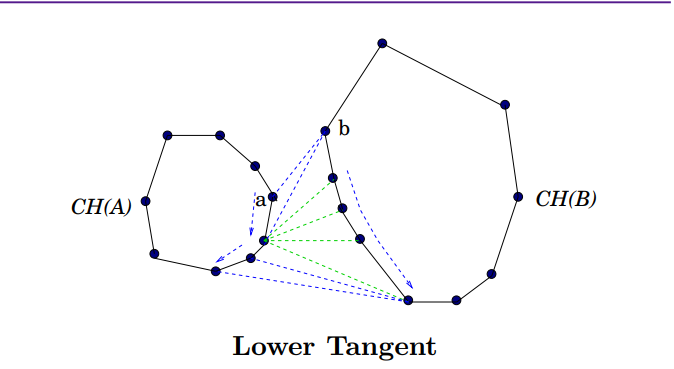Graham Scan
pseudo code
sort by y-order; //$p_1, p_2, ..., p_n$
stack.push($p_1, p_2$);
for i = 3 to $n$ do
while next $\angle next, top, $p_i$ != CCW
stack.pop()
stack.push($p_i$)
return stack
Analysis of Graham Scan
- Invariant $<p_1, … ,stack.top()>$ is convex
- 기울기 공식:
$D = det\begin{vmatrix} 1 & p_x & p_y \ 1 & q_x & q_y \ 1 & r_x & r_y \end{vmatrix}$
- if $D > 0$ then $\angle p, q, r$ is CCW
- else if $D < 0$ $\angle p, q, r$ is CW
- else then $\angle p, q, r$ is straight
- $D = p \cdot (q \times r)$ 이다.
- 정렬 이후 $O(n)$번의 스캔이 일어나며 반복 수행마다 $logn$의 시간 소요
- time complexity: $O(nlogn)$
Divide and Conquer
pseudo code

- sort by x-order
- Let $A$ be the set of $n/2$ leftmost points and $B$ the set of $n/2$ rightmost points
- Reculsively compute $CovexHull(A)$ and $ConvexHull(B)$
- Merge to obtain CovexHull(S)
- a = rightmost point of $CovexHull(A)$
- b = leftmost point of $ConvexHull(B)$
- while $\overline{ab}$ not lower tangent of $CovexHull(A)$ and $ConvexHull(B)$
- while $\overline{ab}$ not lower tangent to :$ConvexHull(A)$
- set $a = a-1$(move $a$ $CW$)
- while $\overline{ab}$ not lower tangent to :$ConvexHull(B)$
- set $b = b+1$(move $b$ $CCW$)
- return $\overline{ab}$
Analysis of Divide and conquer
- 처음 정렬에 걸리는 시간 $O(nlong)$
- . $T(N) = 2T(N/2) + O(N)$
- Merge 즉, 합치는 데 걸리는 시간은 선형이다.
- 마스터 정리에 의하여 $T(N) = O(nlogn)$
References
